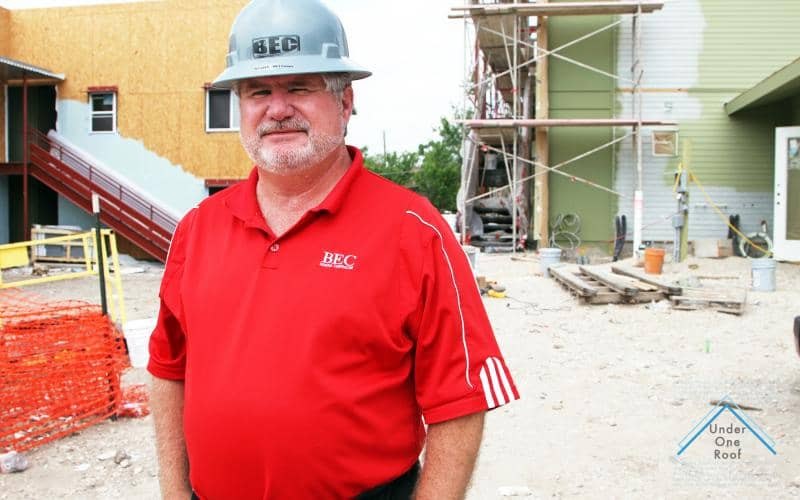
Under One Roof: Who Develops Affordable Housing for Austin?
Scott Wilson interviewed by KUT
By JOY DIAZ • Photo credit: Filipa Rodrigues, KUT NEWS
Listen to the original Interview recording on KUT's site
It’s early morning – still dark outside – and Walter Moreau is already done with his morning run. When I meet him he’s downtown, getting ready for his workout.
“I think there’s a lot of things here in the gym that translate to work,” he says.
Moreau leads Foundation Communities – Austin’s largest non-profit builder and manager of affordable housing.
“It’s that intensity, that can-do attitude that coaches are barking at you,” he says. “And if I can take that into the rest of the workday, I can help solve problems and build more housing.”
“Build more housing” sounds like a focused, achievable goal. But it’s a challenge. It comes with many moving parts. That’s why Moreau spends the early hours of his days at the gym. It helps him strategize.
On any given day he juggles three to five projects – each in different stages of completion. To better understand how Moreau keeps his projects straight, I imagined him hauling around a clipboard with a checklist for each.
“First you have the dream,” he says – check.
“Then you gotta go find the site” – check.
“We have to compete for housing tax credits” – check. Next on the checklist: community support, city building permits, design, construction, then leasing.
“Then, the U-Haul trucks move up and people move in,” he says. “Then I cry, and it’s like three years later you finally get to see it happen.”
And when Moreau does cry, he says it’s tears of joy. As the Executive Director of Foundation Communities, Moreau is part builder, part CEO, part finance expert, part social worker.
Stuart Hersh is a local housing consultant. He tells me affordable housing in Austin is mostly built by people like Moreau.
“Under the best of circumstances, historically it is both for-profit builders and non-for-profit organizations,” Hersh says. “But, when the environment of regulation and the land prices get to a certain point” – an all time high, like they are right now – “then you end up getting almost all the affordable housing built only by not-for-profit organizations.”
Out of all its properties, M Station is Foundation Communities’ pride and joy.
It was built close to downtown and within walking distance from many services. It serves people of different incomes: some formerly homeless, some middle-class, and some in between.
Architect Tom Hatch and his team designed M Station. When he talks about the project, his words are like music. “Design is rhythm, color, texture, proportion, detail, light, wind, orientation,” he says.
But I don’t know how those words translate into affordable housing – when they sound like such an expensive proposition.
“How about I bring you some pictures?” Hatch asks.
He returns with lots of visuals: some of M Station’s original design, and some of the final version – the one that fit with the project’s funding.
“We did a lot of sun-shades on the West side, the bulk of those got removed. And we just put sunscreens on the windows. Cool. Big savings,” he says. “And they wanted this option here with lots of stone – Ca-Ching! Ca-Ching! OK? Well, we ended up with about this much stone here and here – as the entry, to give it a sense of warmth.”
Hatch spent less money – but the essence of the development is still the same.
Randall Owen is part of the design team. He says they always adhere to a budget – but he wants to make clear that building affordable housing is not a synonym for building cheap housing
“You need to spend the money upfront on quality materials and things, to not spend the money later on replacing and fixing things,” he says.
Scott Wilson couldn’t agree more. He's a builder who’s working on an affordable housing development for seniors.
Wilson explains how an upfront expense saves money in the future. “Our front door is a hollow metal frame,” he says. “So it costs more to put in but it will last forever, it’s also more secure. Our windows will be high-performance windows.”
The windows, plus the sprayed insulation, will save on energy bills. Many of these features would be considered upgrades at a commercial property.
“At a commercial project,” Wilson says, “the owner often may only be there for four or five years. Although they build good projects, they make a little different choices sometimes, because they are worried about first costs as much as anything.”
It seems very little differentiates an affordable housing project from a market rate one. Designers focus on what their client wants and what they can afford. Builders do the same.
But if so little is different, why aren’t there more for-profit builders tapping into the affordable housing market?
“It’s really not that big a market,” Wilson says. “There’s not enough being built.” But why?
Advocates will tell you there’s a shortage of at least 30,00 affordable homes for families whose yearly incomes are below $22,000. So, the need is there. The money is another story. We’ll hear more about that tomorrow.
